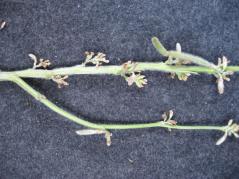July 19, 2012

With no relief from the ongoing drought in sight, crop ratings continue to drop. University of Illinois crop sciences professor Emerson Nafziger said that only 11 and 17% of Illinois corn and soybean crops, respectively, were rated as good or excellent on July 15.
Corn crop prospects continue to worsen with loss of leaf area and poor or failed pollination in dry areas. As leaf color and area continue to decline, so does yield potential.
“While we remain more optimistic about soybean prospects than about corn, soybean yield potential is beginning to decline as more time passes without enough water to keep plants functioning well,” Nafziger said.
Soybean plants in dry areas are short, and the size of leaves and petioles has been reduced due to the ongoing lack of available water to expand cells. The result has been plants with a narrow canopy. In wider rows, plants are unable to join canopies across the rows, which reduces their ability to intercept sunlight and lowers their yield potential.
 A more pressing problem is the lack of pod formation, at least in early-planted fields. By mid-July, pods should be abundant on these plants. Instead, the lower nodes may have few or no pods set (Figure 1). As stress continues, racemes above these lower nodes may continue to dry up and pods either will not form or will drop off.
A more pressing problem is the lack of pod formation, at least in early-planted fields. By mid-July, pods should be abundant on these plants. Instead, the lower nodes may have few or no pods set (Figure 1). As stress continues, racemes above these lower nodes may continue to dry up and pods either will not form or will drop off.
The yield potential of stressed soybean plants depends on their ability to respond to rainfall by producing more nodes at the top of the plant and then by flowering and setting pods on these nodes.
“For now, racemes on upper nodes have a good number of flower, and some pods are forming at these upper nodes,” said Nafziger. “However, if weather conditions remain as they are, small pods may abort. Even larger pods may begin to drop off the plants.”
As the number of “spent” racemes continues to increase in stressed plants, pod number, and hence yield potential, will continue to decline. New racemes and pods that will form following rain can help to overcome some of this loss, but the lack of a full canopy will also limit the number of pods that can be filled.
As is the case with corn, final yield in the soybean plant depends on how much sugar the leaves can supply through photosynthesis. When the supply is short during flowering, pod numbers decline; when the supply is short during pod filling, pods will drop early or, if they stay on, seed size can be reduced.
Because later-planted soybeans retain more flexibility in the numbers of racemes, flowers, and pods compared to those planted early, a return to better conditions may help the later-planted crop more than it helps early-planted soybeans.
On the negative side, later-planted soybeans are shorter and have fewer nodes than those planted early, and the root system is probably not as extensive as in the early-planted crop. However, if stress is relieved by late July, it is possible that later-planted soybeans might set more pods and produce more yield than those planted in April.
“It might seem reasonable to try to protect yield potential by applying fungicides, insecticides, and perhaps other products that promise to relieve stress in soybean crops,” Nafziger said. “But when lack of water is as overwhelming a factor as it is this year, it is unlikely that any inputs other than irrigation will do much to help. While it is important to scout for and manage pests that can add to stress, there is little data showing that a crop under severe stress can have its physiology and yield potential improved by additives.”
You May Also Like




